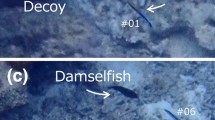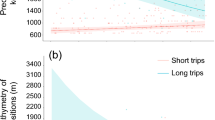Abstract
Human-induced eutrophication, resulting in algal blooms and increased water turbidity, is an alarming problem in aquatic systems. Here, we experimentally tested the impact of algal turbidity on parental care, egg fanning, and time in the nest, in the sand goby, Pomatoschistus minutus, a fish with uniparental male care. We allowed males to care for their eggs in either clear water or water made turbid by planktonic algae. In the early brood cycle, males fanned their eggs less in turbid than in clear water, but this difference disappeared later. Despite decreased care, egg survival was higher in turbid conditions, indicating that early fanning may partly be redundant for egg survival and perhaps used more as courtship. Males also spent more time out of their nest in turbid water, perhaps as a means to encounter additional females under conditions of low visibility.



Similar content being viewed by others
References
Cederwall H, Elmgren R (1990) Biological effects of eutrophication in the Baltic Sea, particularly the coastal zone. Ambio 19:109–112
Clutton-Brock TH (1991) The evolution of parental care. Princeton University Press, Princeton
Coleman RM, Fischer RU (1991) Brood size, male fanning effort and the energetics of a nonshareable parental investment in bluegill sunfish, Lepomis macrochirus (Teleostei: Centrarchidae). Ethology 87:177–188
Elmgren R (1989) Man's impact on the ecosystem of the Baltic Sea: energy flows today and at the turn of the century. Ambio 18:326–332
Engström-Öst J, Candolin U (2007) Human-induced water turbidity alters selection on sexual displays in sticklebacks. Behav Ecol 18:393–398
Fonds M (1973) Sand gobies of the Dutch Wadden Sea (Pomatoschistus, Gobiidae, Pisces). Neth J Sea Res 6:417–478
Forsgren E (1992) Predation risk affects mate choice in a gobiid fish. Am Nat 140:1041–1049
Forsgren E (1997a) Female sand gobies prefer good fathers over dominant males. Proc R Soc Lond B 264:1283–1286
Forsgren E (1997b) Mate sampling in a population of sand gobies. Anim Behav 53:267–276
Giacomello E, Marchini D, Rasotto MB (2006) A male sexually dimorphic trait provides antimicrobials to eggs in blenny fish. Biol Lett 2:330–333
Green BS, McCormick MI (2005) O2 replenishment to fish nests: males adjust brood care to ambient conditions and brood development. Behav Ecol 16:389–397
Hale RE, St.Mary CM, Lindström K (2003) Parental responses to changes in costs and benefits along an environmental gradient. Environ Biol Fish 67:107–116
Iwasa Y, Pomiankowski A (1999) Good parent and good genes models of handicap evolution. J Theor Biol 200:97–109
Järvenpää M, Lindström K (2004) Water turbidity by algal blooms causes mating system breakdown in a shallow-water fish, the sand goby Pomatoschistus minutus. Proc R Soc Lond B 271:2361–2365
Jones JC, Reynolds JD (1999) Costs of egg ventilation for male common gobies breeding in conditions of low dissolved oxygen. Anim Behav 57:181–188
Kirkpatrick M (1985) Evolution of female choice and male parental investment in polygynous species: the demise of the “sexy son”. Am Nat 125:788–810
Knouft JH, Page LM, Plewa MJ (2003) Antimicrobial egg cleaning by the fringed darter (Perciformes: Percidae: Etheostoma crossopterum): implications of a novel component of parental care in fishes. Proc R Soc Lond B 270:2405–2411
Kokko H, Rankin DJ (2006) Lonely hearts or sex in the city? Density-dependent effects in mating systems. Proc R Soc Lond B 361:319–334
Künzler R, Bakker TCM (2000) Pectoral fins and paternal quality in sticklebacks. Proc R Soc Lond B 267:999–1004
Kvarnemo C (2006) Evolution and maintenance of male care: is increased paternity a neglected benefit of care? Behav Ecol 17:144–148
Lindström K (1992) Female spawning patterns and male mating success in the sand goby Pomatoschistus minutus. Mar Biol 113:475–480
Lindström K, St. Mary CM, Pampoulie C (2006) Sexual selection for male parental care in the sand goby, Pomatoschistus minutus. Behav Ecol Sociobiol 60:46–51
Lissåker M, Kvarnemo C (2006) Ventilation or nest defense—parental care trade-offs in a fish with male care. Behav Ecol Sociobiol 60:864–873
Lissåker M, Kvarnemo C, Svensson O (2003) Effects of a low oxygen environment on parental effort and filial cannibalism in the male sand goby, Pomatoschistus minutus. Behav Ecol 14:374–381
Mertz JC, Barlow GW (1966) On the reproductive behavior of Jordanella floridae (Pisces: Cyprinodontidae) with special reference to a quantitative analysis of parental fanning. Z Tierpsychol 23:537–554
Muller R, Stadelmann P (2004) Fish habitat requirements as the basis for rehabilitation of eutrophic lakes by oxygenation. Fish Manag Ecol 11:251–260
Östlund S, Ahnesjö I (1998) Female fifteen-spined sticklebacks prefer better fathers. Anim Behav 56:1177–1183
Pampoulie C, Lindström K, St.Mary CM (2004) Have your cake and eat it too: male sand gobies show more parental care in the presence of female partners. Behav Ecol 15:199–204
Perttilä M, Niemistö L, Mäkelä K (1995) Distribution, development and total amount of nutrients in the Gulf of Finland. Estuar Coast Shelf Sci 41:345–360
Potts GW, Keenleyside MHA, Edwards JM (1988) The effect of silt on the parental behavior of the sea stickleback, Spinachia spinachia. J Mar Biol Assoc UK 68:277–286
Reebs SG, Whoriskey JFG, FitzGerald GJ (1984) Diel patterns of fanning activity, egg respiration, and the nocturnal behavior of male three-spined sticklebacks, Gasterosteus aculeatus L. (f. trachurus). Can J Zool 62:329–334
Roff DA (1992) The evolution of life histories. Chapman & Hall, New York
Sanden P, Håkansson B (1996) Long-term trends in Secchi depths in the Baltic Sea. Limnol Oceanogr 41:346–351
Sanden P, Rahm L (1993) Nutrient trends in the Baltic Sea. Environmetrics 4:75–103
Sargent RC, Gross MR (1993) William's principle: an explanation of parental care in teleost fishes. Chapman & Hall, London, pp 333–361
Seehausen O, van Alphen JJM, Witte F (1997) Cichlid fish diversity threatened by eutrophication that curbs sexual selection. Science 277:1808–1811
Tallamy DW (2000) Sexual selection and the evolution of exclusive paternal care in arthropods. Anim Behav 60:559–567
Torricelli P, Lugli M, Gandolfi G (1985) A quantitative analysis of the fanning activity in the male Padogobius martensi (Pisces: Gobiidae). Behaviour 92:288–301
van Iersel JJA (1953) An analysis of the parental behaviour of the three-spined stickleback (Gasterosteus aculeatus L.). Behaviour Suppl 3:1–159
Williams GC (1966) Natural selection, the cost of reproduction and a refinement of Lack's principle. Am Nat 100:687–690
Wong BBM, Candolin U, Lindström K (2007) Environmental deterioration compromises socially enforced signals of male quality in three-spined sticklebacks. Am Nat 170:184–189
Acknowledgments
We would like to thank Hanna Kokko, Colette St. Mary, Bob Wong and Lotta Kvarnemo for the comments on earlier drafts of this manuscript. We also like to thank Topi Lehtonen, Maria Järvi-Laturi, Kaisa Mäki-Kihniä, Veli-Pekka Antti-Poika, Ilkka Anttila and Hope Klug for the help in the field. Financial support was received from Maj and Tor Nessling foundation (to M.J.); Graduate School in Evolutionary Ecology (to M.J.); Onni Talas foundation (to M.J.); the Finnish Academy (211973 to K.L.). This study has been approved by the University of Helsinki animal housing authorities, permit no. HY 46–03.
Author information
Authors and Affiliations
Corresponding author
Additional information
Communicated by M. Jennions
Rights and permissions
About this article
Cite this article
Järvenpää, M., Lindström, K. Algal blooms decrease care but increase egg survival in a fish with paternal care. Behav Ecol Sociobiol 65, 2023–2028 (2011). https://doi.org/10.1007/s00265-011-1211-5
Received:
Revised:
Accepted:
Published:
Issue Date:
DOI: https://doi.org/10.1007/s00265-011-1211-5




